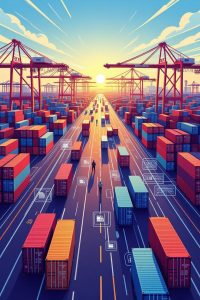 Trade between India and China reached over $118 billion in 2023, making their economic corridor one of the most vibrant in Asia. This level of commerce demands seamless financial infrastructure. Modern cross-border payment gateways have stepped into this role, becoming silent architects of smoother transactions. By removing traditional bottlenecks, these gateways are shaping a new rhythm of trade, where goods and services flow more freely between the two nations.
Trade between India and China reached over $118 billion in 2023, making their economic corridor one of the most vibrant in Asia. This level of commerce demands seamless financial infrastructure. Modern cross-border payment gateways have stepped into this role, becoming silent architects of smoother transactions. By removing traditional bottlenecks, these gateways are shaping a new rhythm of trade, where goods and services flow more freely between the two nations.
Platforms like Tata Payment which supports Indian payment system (印度支付通道) are transforming how small and large enterprises conduct business across borders. Through instant settlements, reduced processing costs, and user-friendly integration, these systems enable Chinese exporters and Indian buyers to trade without worrying about outdated banking delays. This creates a trust-based environment where companies of all sizes can expand, while governments benefit from greater transparency and data-driven oversight.
The Role of Payment Gateways in Bilateral Commerce
Every transaction tells a story of cooperation. Cross-border payment gateways like TataPayment.net support that story by reducing friction. They provide fast currency conversion, secure channels for payments, and streamlined verification processes. This efficiency cuts costs for businesses and creates new opportunities for collaboration in manufacturing, e-commerce, and logistics. For small suppliers in China, these systems act as a bridge to India’s expanding consumer base.
These gateways also enhance regulatory compliance. By working closely with financial institutions in both countries, they ensure that anti-money laundering checks and tax obligations are easier to meet. This reduces the risk of fraud and strengthens investor confidence, which in turn boosts the volume of bilateral trade. “Payment infrastructure is the new port,” remarked an Indian trade analyst, “It moves value as efficiently as ships move goods.”
Impact on GDP and Economic Growth
The influence of cross-border payment solutions extends beyond merchants to national economies. When payment delays are minimized, businesses can reinvest their capital more quickly. This accelerates production cycles and raises GDP contributions on both sides. India benefits from a surge in imports of essential goods, while China gains access to one of the world’s fastest-growing consumer markets. The ripple effects touch transport, insurance, and warehousing sectors, amplifying the economic corridor’s reach.
Lower transaction costs directly stimulate growth. According to a study by an independent think tank, reducing cross-border payment fees by just 1% could add billions to bilateral trade over five years. This is especially significant for smaller exporters who previously relied on costly intermediaries. With digital gateways, they can compete on better terms, widening the scope of trade partnerships between India and China.
Technological Innovation Driving Trust
Technology sits at the heart of these changes. Payment gateways now use encryption, tokenization, and artificial intelligence to detect anomalies. This builds trust between buyers and sellers who may never meet in person. It also aligns with the growing push for digital governance in both countries. By integrating with customs, tax, and shipping platforms, these systems reduce paperwork and speed up clearance, making cross-border trade less daunting.
The Indian payment system is a good example of this innovation in action. Its architecture prioritizes security and scalability, ensuring that even during peak shopping seasons, payments are processed smoothly. Such reliability is critical for maintaining customer satisfaction and supplier confidence. It signals to the world that India and China are serious about building a digital-first trade corridor.
Benefits Beyond Business
The impact of these gateways reaches everyday people. Students paying tuition fees, families sending remittances, and freelancers working across borders all benefit from faster, cheaper, and safer transactions. This human dimension adds a layer of social connection to what might otherwise be seen as purely economic infrastructure. It fosters goodwill and mutual understanding between the two nations.
Cross-border payments also encourage cultural exchange. When artists, small-scale producers, and service providers can receive payments effortlessly, they participate more fully in the global market. This softens the boundaries of commerce and makes the India–China corridor not just a highway of goods but a bridge of shared aspirations.
READ ALSO: Navigating Finance, Trading Platforms, and Expert Broker Strategies
Looking Ahead: A Stronger Corridor
The future of India–China trade will depend on how well payment solutions continue to evolve. As both nations push for digital transformation, collaboration on standards, cybersecurity, and interoperability will be essential. Cross-border payment gateways must keep pace with changing regulations, emerging currencies, and new trade patterns. By doing so, they can anchor the corridor’s stability and growth for decades to come.
Ultimately, platforms like Tata Payment which supports Indian payment systems show that financial technology is not just a back-end service but a driver of economic destiny. By enabling smoother transactions, these systems empower businesses, support GDP growth, and deepen the partnership between Asia’s two largest economies. As they continue to evolve, they will keep strengthening the India–China economic corridor and shaping a more interconnected future.



 A Georgia lawsuit funding is an option considered by a plaintiff as a means to pursue claims for damages beyond the amount offered as settlement by insurance companies. While a personal injury lawsuit can help a car crash victim claim compulsory damages in terms of
A Georgia lawsuit funding is an option considered by a plaintiff as a means to pursue claims for damages beyond the amount offered as settlement by insurance companies. While a personal injury lawsuit can help a car crash victim claim compulsory damages in terms of  In Georgia, the victim of a car collision can file a lawsuit to claim damages only if he or she is not at fault for causing the collision. The At Fault rule bars the driver in a car collision from pursuing claims for damages if his percentage of fault exceeded that of the other driver.
In Georgia, the victim of a car collision can file a lawsuit to claim damages only if he or she is not at fault for causing the collision. The At Fault rule bars the driver in a car collision from pursuing claims for damages if his percentage of fault exceeded that of the other driver.












 Your client previously assured you that your invoice will be paid, however they leave the invoice unpaid and ignore and don’t respond to your letters and calls. When you have exerted all possible measures to get paid, what else can you do? One of the best options to consider is to hire an experienced debt collection agency as they are aware of and understand the different laws and legalities in order to quickly and effectively recover what is due to you.
Your client previously assured you that your invoice will be paid, however they leave the invoice unpaid and ignore and don’t respond to your letters and calls. When you have exerted all possible measures to get paid, what else can you do? One of the best options to consider is to hire an experienced debt collection agency as they are aware of and understand the different laws and legalities in order to quickly and effectively recover what is due to you. For your business or company to remain afloat, you need to collect the payments for the
For your business or company to remain afloat, you need to collect the payments for the  Comprehensive Documentation
Comprehensive Documentation